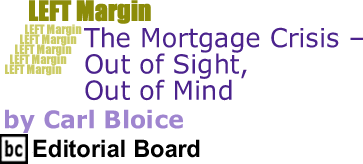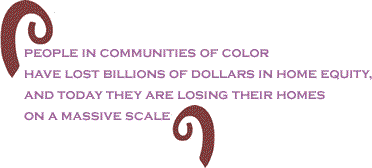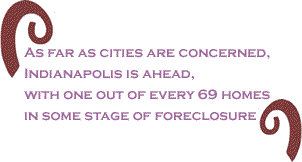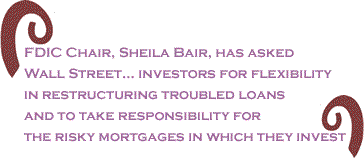
|
|||||||||||||||||||||
|
||||||||||
|
The current issue is always free to everyone If
you need the access available to a |
||||||||||
 |
||||||||||
There are a lot of things you wouldn’t know from reading most of the papers or watching the TV. For instance, there were demonstrations and press conferences across the country earlier this month, demanding action to deal with the growing crisis in the home ownership business. Major civil rights and housing groups have called for a moratorium on the home foreclosures that are devastating individuals and families, and hitting African Americans and Latinos at a disproportionate rate. After a flurry of interest this spring, the major media - having been sold on the dubious idea that the sub-prime mortgage calamity won’t spill over to the larger economy - have pretty much dropped the story. (The New York Times, did run a front page story, June 12, on counseling for borrowers, accompanied by a devastating graphic showing the foreclosure carnage underway in Black and Latino neighborhoods in Chicago). The one thing most ignored is any suggestion that something might be done to rescue people now threatened with losing their homes. “As the nation seeks to recover from the devastation caused by reckless sub-prime lending, we must squarely address the disproportionate impact on African-Americans and Latinos and other traditionally underserved communities,” read a statement issued April 4 by a coalition of rights and housing groups. “For years, sub-prime lenders have targeted communities of color and aggressively marketed dangerous and abusive loans. As a result, people in communities of color have lost billions of dollars in home equity, and today they are losing their homes on a massive scale.” National civil rights groups, including the Leadership Conference on Civil Rights, the NAACP, the National Fair Housing Alliance, the National Council of La Raza, and the Center for Responsible Lending, have called for mortgage lenders, loan servicers and investors who hold unaffordable sub-prime loans with “payment shock” all over the country, to "institute an immediate six-month moratorium on sub-prime home foreclosures and to work actively with homeowners to help them keep their homes by putting these borrowers into affordable loan products." “Lenders, servicers and investors have a variety of tools at their disposal to restructure or otherwise change the terms of mortgages to provide relief to homeowners who now struggle with unaffordable loans that were never designed to be sustainable,” the groups said. “The six months will be time for the industry to work with these groups to establish benchmarks and set long-term goals for easing the foreclosure crisis and to assist borrowers.”
“The need for a moratorium on foreclosures of unaffordable sub-prime loans with ‘payment shock’ is urgent,” the statement went on. “If lenders, servicers, Wall Street and policymakers allow the flood of sub-prime foreclosures to continue rising unchecked, years of economic progress in communities of color will be wiped out, and the racial wealth and equity gap will widen even further. Borrowers must be put into affordable loan products now.” Well, over six weeks have passed since that call was made and there’s been no action, no moratorium and, for most people, no knowledge that such a suggestion was ever made. We’re in the middle of a premature Presidential election cycle and three of the leading candidates have had a little to say about the situation. Senators Hillary Clinton of New York, Christopher J. Dodd of Connecticut and Barack Obama of Illinois have demanded federal action to prevent a recurrence of the such a crisis, but as the Los Angeles Times notes, none of them “has offered more than general ideas for aiding borrowers, and none has called for a massive federal assistance program.” And, if you think the lack of attention to the mortgage crisis means it has subsided, think again. “Anyone who believes that the worst is over in the sub-prime mortgage fiasco need merely wait awhile,” wrote New York Times business commentator Gretchen Morgenson. “A tsunami of interest rate increases on these loans is headed your way.” “During the next five years, some $1 trillion in adjustable-rate mortgages will reset,” wrote Morgenson, who hasn’t let the story go and who has penned the most informative reports on it. “But in the here and now - from just June to October this year - more than $100 billion of that amount is scheduled to reset, and all of it is in loans that are in the riskier sub-prime category. Given the recent interest rate spike, many of those loans that once carried low teaser rates are on track to reset to at least 11 percent - or more than four percentage points higher than the current rate on a conventional, 30-year home loan.” “Chances are slim that even the most creditworthy borrowers can survive payment shocks like these,” writes Morgenson. “And so, as the reset storm hits, delinquencies will rise and foreclosures will follow,” adding it is too early to tell how many foreclosures to expect but cites a RealtyTrac report that say there were 1.2 million in 2006.
Three quarters of the home loans made in the first half of last year are now past the delinquency rate projected when their mortgages were packaged and sold to investors, writes Morgenson. “Add to this grim picture the fact that many of the loans taken out most recently are held by people who probably have little or no equity in their homes. As prices soften further, these borrowers will find themselves ‘upside down’ - owing more on their mortgage than their houses are worth.” “None of this bodes well for home prices, which are already flat or falling. Then again, this is what a mania always looks like when it unravels,” she adds. On June 4, the new Federal Reserve Chairman Ben Bernanke admitted the residential real estate slowdown "appears likely to remain a drag on economic growth for somewhat longer than previously expected," but once again expressed his faith that the slowdown won’t adversely affect the larger economy – a seeming contradiction. In San Francisco, on June 6, members of the Association of Community
Organizations for Reform Now (ACORN),
held a press conference in front of the local office of the Federal
Reserve Bank calling on the Fed to take action to protect homeowners
from unregulated sub-prime loans, and for Bernanke to issue regulations
to protect hard-working families from predatory lending practices. "We're
asking the Federal Reserve to use the power that it has to regulate
the industry more strictly so that brokers and lenders take some
responsibility for their actions,” predatory lending victim Jackie
Phillips told the online Beyond Chron (the real San
Francisco Chronicle didn’t bother to cover the event).
In California in 2006, there were 142,429 foreclosure filings - up 131% from 2005 and the third largest percentage increase in the country. That’s one foreclosure filing for every 86 households in the state, the 14th highest foreclosure rate in the country. Nationally, there were 323,102 mortgage defaults between January and March, compared with 188,122 during the same period last year — an increase of 72 percent. As far as cities are concerned, Indianapolis is ahead, with one out of every 69 homes in some stage of foreclosure. For Atlanta, it’s 1 in 70 homes, followed by Dallas, 1 in 99, and Memphis, 1 in 101, with Denver registering 1 in 105. “People sign up for loans with one interest payment, and, oftentimes, unknown to them, two years later it is completely different,” San Francisco ACORN member Valarie Adams told Beyond Chron. “This will be an epidemic as more and more people will be forced out of their homes; families will have no place to go.” “Our objective is to make sure the hard working families will get protections, justice and have peace a mind, instead of continuing to have sleepless nights,” said Adams. Meanwhile, Federal Deposit Insurance Corporation (FDIC) Chair, Sheila Bair, has urged Wall Street to help solve the mortgage crisis for borrowers with bad credit. In a recent address to the American Securitization Forum, a group that represents the people who bundle and sell mortgages to investors, she asked investors for flexibility in restructuring troubled loans and to take responsibility for the risky mortgages in which they invest. "There's a lot of money at stake, and millions of people whose homes are on the line," she said.
ACORN says it favors legislation that would prohibit lenders from making mortgages that the borrower clearly has no ability to repay, either from the beginning or after the interest rate increases. Further, that lenders be held responsible for the actions of brokers and that repayment penalties on sub-prime loans be reduced or eliminated. They are also asking that the state attorney general prevent foreclosures on predatory loans and the county sheriffs and courts refuse to conduct foreclosure sales or auctions on the properties. When asked what the community and other organizations and institutions can do, Adams told Beyond Chron, “go to every nook and cranny, every neighborhood and let them know the severity behind this and get them to help because you could be next.” BC Editorial Board member Carl Bloice is a writer in San Francisco, a member of the National Coordinating Committee of the Committees of Correspondence for Democracy and Socialism and formerly worked for a healthcare union. Click here to contact Mr. Bloice. |
||||||||||
| June
21, 2007 Issue 234 |
|
| Printer Friendly Version in resizeable plain text format |
 |
 |
 |
| |
| |





































